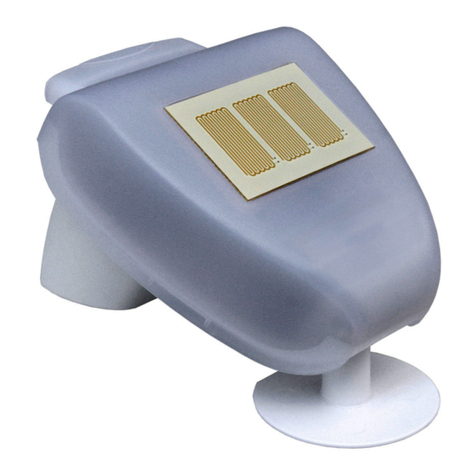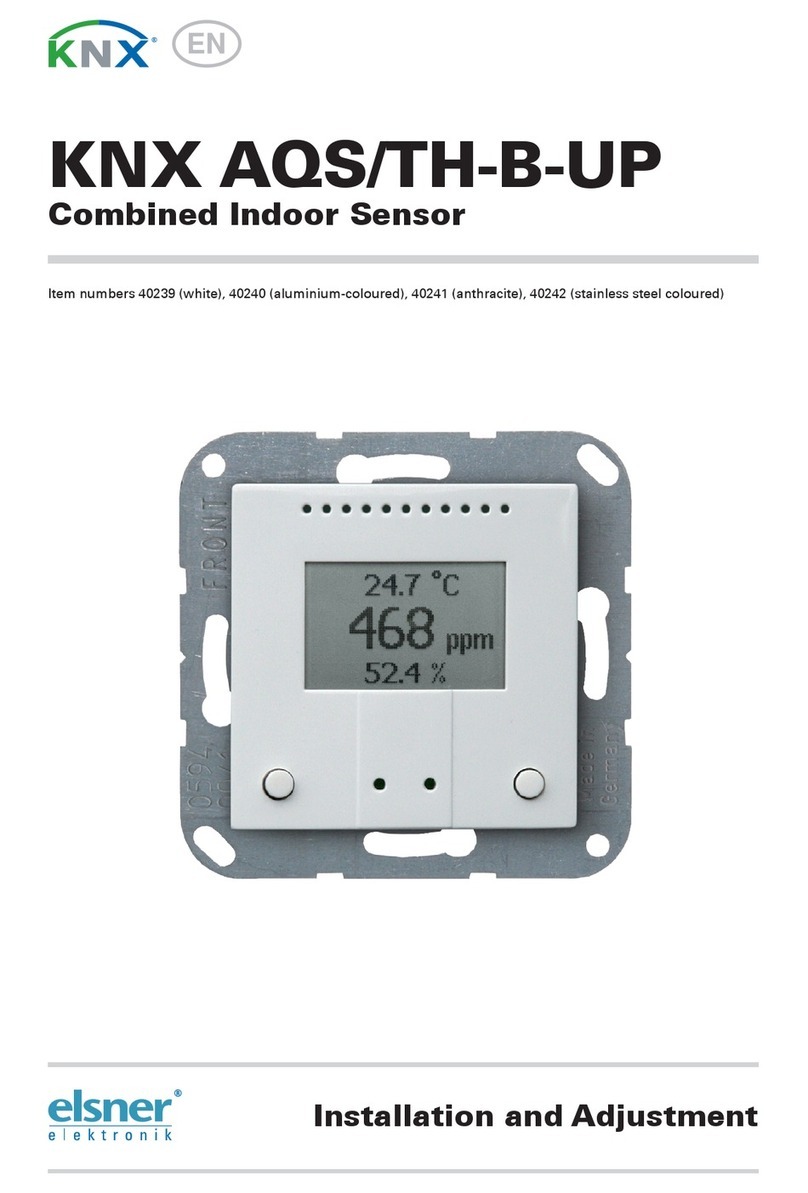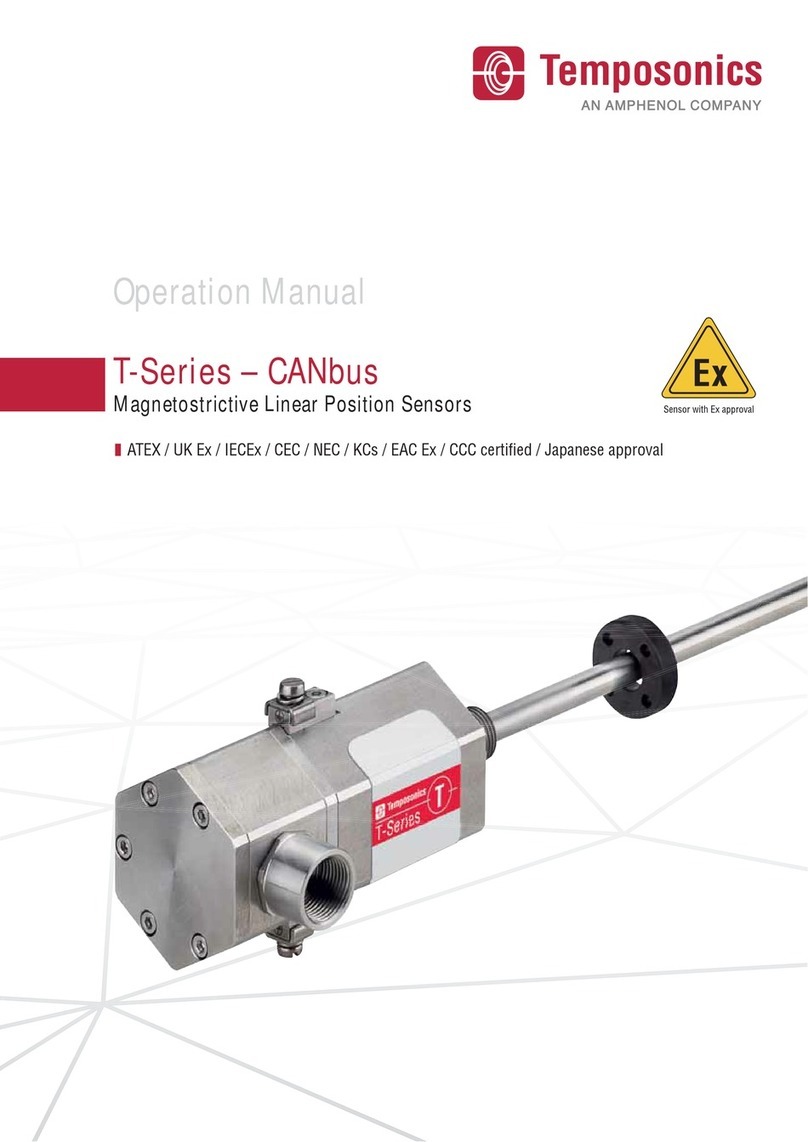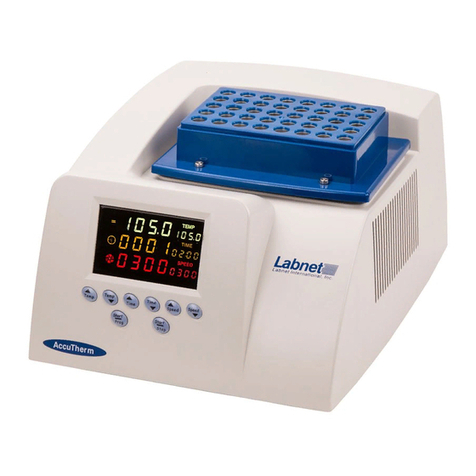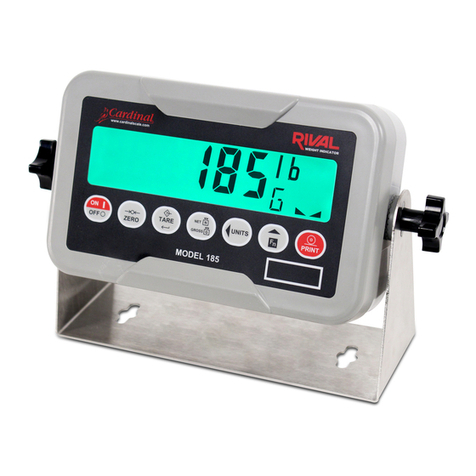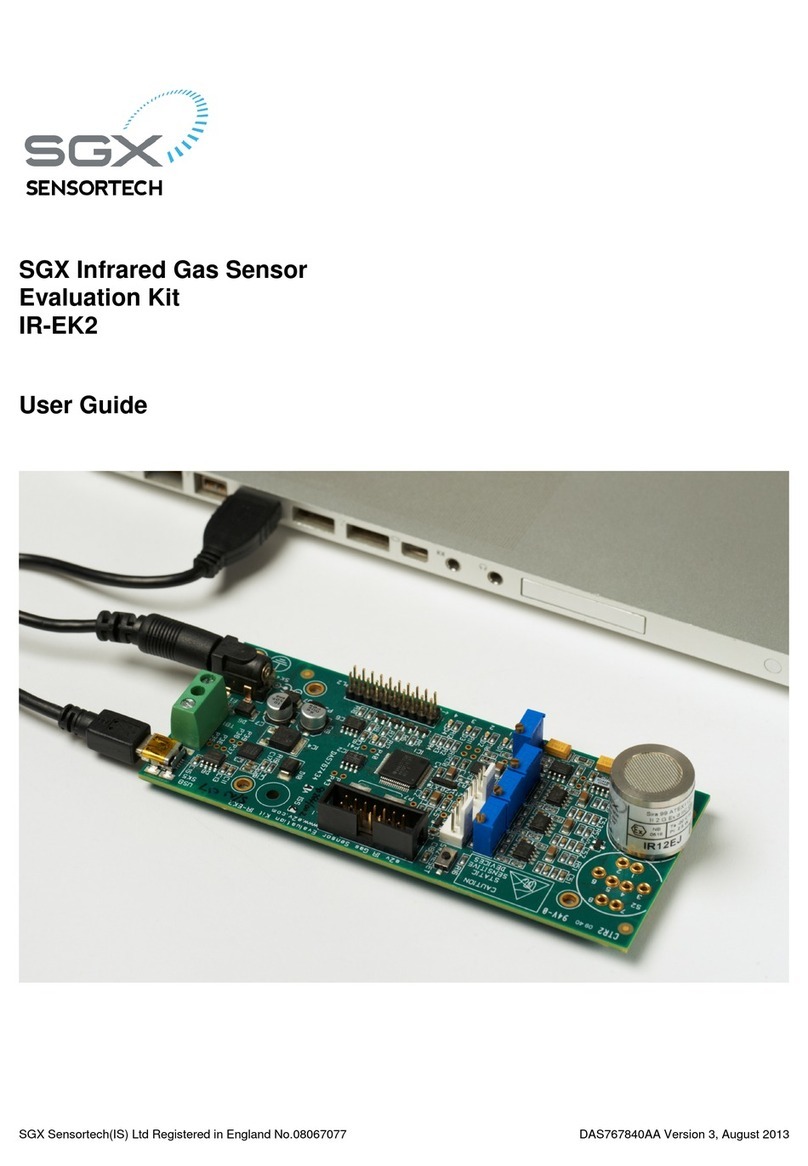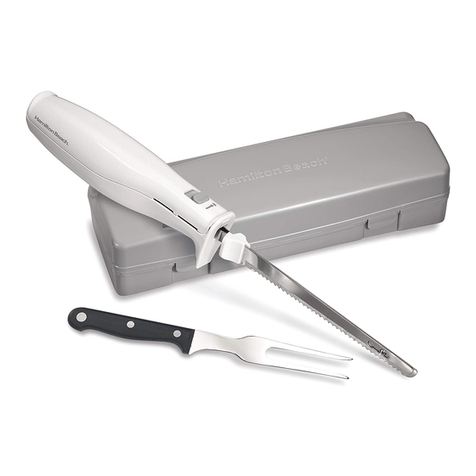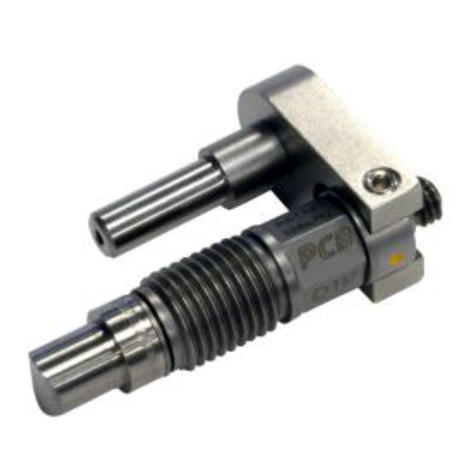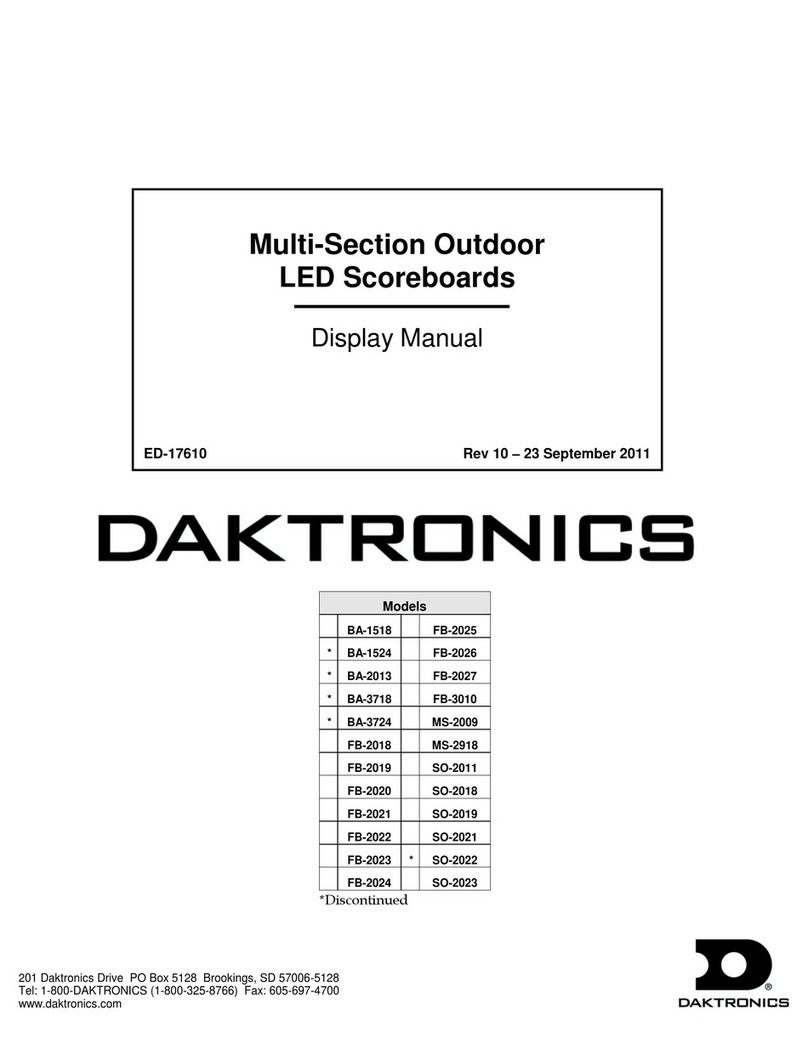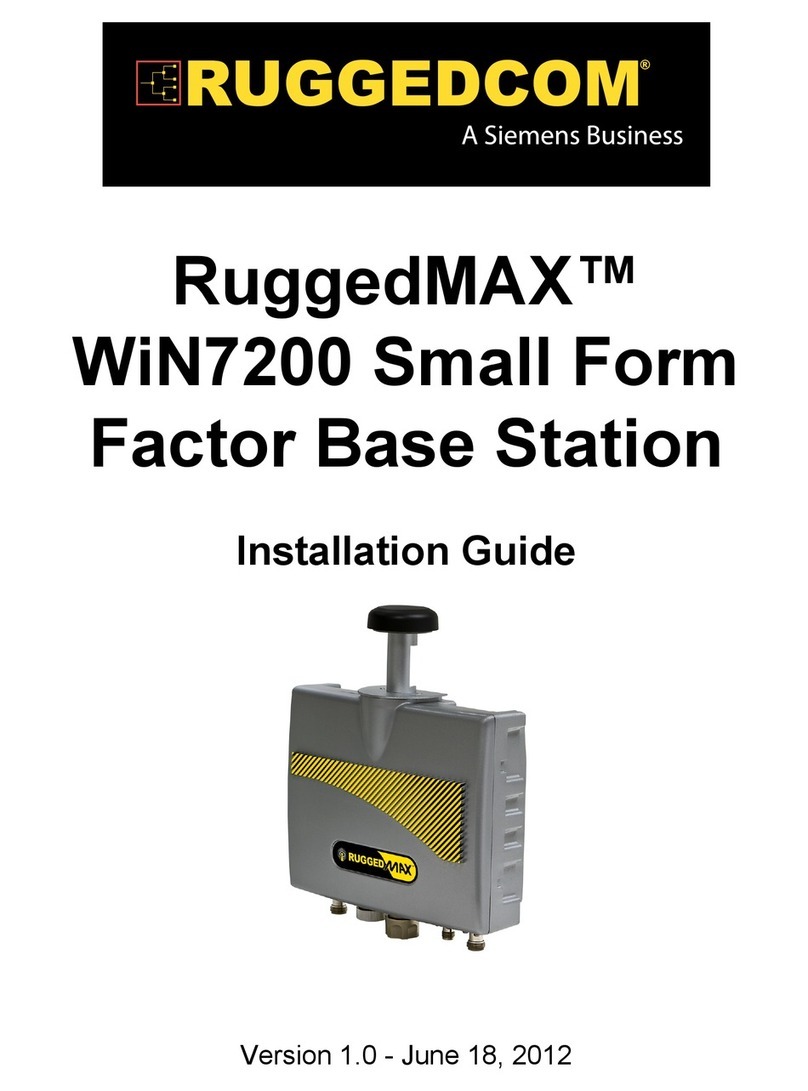Elsner KNX T-UP gl Guide

KNX T-UP gl
Temperature Sensor
Item numbers 70631 (black), 70632 (pure white)
EN
Installation and Adjustment


1 Content
Elsner Elektronik GmbH • Sohlengrund 16 • 75395 Ostelsheim • Germany
Sensor KNX T-UP gl from ETS programme version 1.0
Status: 05.09.2022 • Technical changes and errors excepted.
1. Safety and operating instructions ....................................................... 3
2. Description ........................................................................................... 3
3. Commissioning .................................................................................... 4
3.1. Addressing the equipment ...................................................................................... 4
4. Transfer protocol ................................................................................. 5
4.1. List of all communications objects ......................................................................... 5
5. Parameter setting .............................................................................. 11
5.1. Behaviour on power failure/ restoration of power .............................................. 11
5.2. General settings ..................................................................................................... 11
5.3. Temperature value ................................................................................................. 12
5.4. Temperature threshold values .............................................................................. 12
5.4.1. Threshold value 1, 2, 3 ............................................................................... 12
5.4.1.1. Threshold value ............................................................................ 12
5.4.1.2. Switching output .......................................................................... 13
5.4.1.3. Block .............................................................................................. 14
5.5. Temperature PI control .......................................................................................... 15
5.5.0.1. General control ............................................................................. 15
5.5.1. General set point values ............................................................................. 17
5.5.1.1. Set point Comfort ......................................................................... 17
5.5.1.2. Standby setpoint ........................................................................... 18
5.5.1.3. Eco setpoint ................................................................................... 18
5.5.1.4. Setpoint values for frost/heat protection (building protection) 19
5.5.1.5. General control variables ............................................................. 19
5.5.2. Heating control level 1/2 ............................................................................. 20
5.5.3. Cooling control level 1/2 ............................................................................. 22
5.6. Variable comparator .............................................................................................. 24
5.6.1. Control variable comparator 1/2 ................................................................ 24
5.7. Logic ........................................................................................................................ 25
5.7.0.1. AND logic ....................................................................................... 25
5.7.0.2. OR logic ......................................................................................... 25
5.7.1. AND logic 1-4 and OR logic outputs 1-4 ................................................... 25
5.7.1.1. Block .............................................................................................. 27
5.7.2. Connection inputs of the AND logic .......................................................... 27
5.7.3. Connection inputs of the OR logic ............................................................. 28

2 Clarification of signs
This manual is amended periodically and will be brought into line with new software
releases. The change status (software version and date) can be found in the contents footer.
If you have a device with a later software version, please check
www.elsner-elektronik.de in the menu area "Service" to find out whether a more up-to-
date version of the manual is available.
Clarification of signs used in this manual
Safety advice.
Safety advice for working on electrical connections, components,
etc.
DANGER! ... indicates an immediately hazardous situation which will lead to
death or severe injuries if it is not avoided.
WARNING! ... indicates a potentially hazardous situation which may lead to
death or severe injuries if it is not avoided.
CAUTION! ... indicates a potentially hazardous situation which may lead to
trivial or minor injuries if it is not avoided.
ATTENTION! ... indicates a situation which may lead to damage to property if it is
not avoided.
ETS In the ETS tables, the parameter default settings are marked by
underlining.

3 Safety and operating instructions
Sensor KNX T-UP gl • Version: 05.09.2022 • Technical changes and errors excepted.
1. Safety and operating instructions
Installation, testing, operational start-up and troubleshooting should
only be performed by an authorised electrician.
CAUTION!
Live voltage!
There are unprotected live components inside the device.
• Inspect the device for damage before installation. Only put undamaged devic-
es into operation.
• Comply with the locally applicable directives, regulations and provisions for
electrical installation.
• Immediately take the device or system out of service and secure it against un-
intentional switch-on if risk-free operation is no longer guaranteed.
Use the device exclusively for building automation and observe the operating instruc-
tions. Improper use, modifications to the device or failure to observe the operating in-
structions will invalidate any warranty or guarantee claims.
Operate the device only as a fixed-site installation, i.e. only in assembled condition and
after conclusion of all installation and operational start-up tasks, and only in the sur-
roundings designated for it.
Elsner Elektronik is not liable for any changes in norms and standards which may occur
after publication of these operating instructions.
For information on installation, maintenance, disposal, scope of deliv-
ery and technical data, please refer to the installation instructions.
2. Description
The Sensor KNX T-UP gl measures the room temperature. The indoor sensor can
receive an external measured value via the bus and process it with own data to an
overall temperature value (mixed value).
The KNX T-UP gl provides adjustable threshold values. The threshold value outputs
and further communication objects can be linked by AND and OR logic gates.
Additionally, an integrated actuating variable comparator can compare and output
values that are received via communication objects. The sensor has integrated PI
controller for a heating/cooling system.
The device is completed with a frame of the switching series installed in the building
and thus merges with the interior.
Functions:
•Measurement of temperature
•Mixed values from own measured value and external values (proportions can
be set in percentage)

4 Commissioning
Sensor KNX T-UP gl • Version: 05.09.2022 • Technical changes and errors excepted.
•PI controller for heating (one or two step) and cooling (one or two step)
depending on temperature. Control according to separate target values or
basic target temperature
•Threshold values can be adjusted per parameter or via communication
objects: 3 × temperature
•4 AND and 4 OR logic gates with each 4 inputs. Every switching incident as
well as 16 logic inputs in the form of communication objects, may be used as
inputs for the logic gates. The output of each gate may optionally be configured
as 1 bit or 2 x 8 bits
•2 actuating variable comparators for output of minimum, maximum or
average values. Each with 5 inputs (for values received via communication
objects)
3. Commissioning
Configuration is made using the KNX software as of ETS 5. The product file can be
downloaded from the ETS online catalogue and the Elsner Elektronik website on
www.elsner-elektronik.de in the “Service” menu.
After the bus voltage has been applied, the device will enter an initialisation phase
lasting approx. 6 seconds. During this phase no information can be received or sent via
the bus.
3.1. Addressing the equipment
The equipment is delivered with the bus address 15.15.255. Another address can be
programmed using the ETS.
For this purpose there is a button with a control LED on the unit.

5 Transfer protocol
Sensor KNX T-UP gl • Version: 05.09.2022 • Technical changes and errors excepted.
4. Transfer protocol
Units:
Temperatures in degrees Celsius
Air humidity in %
Absolute air humidity in g/kg and/or g/m3
Variables in %
4.1. List of all communications objects
Abbreviation flags:
C Communication
R Read
WWrite
T Transfer
UUpdate
No Text Function Flags DPT Typ Size
0 Software version readable R-CT [217.1]
DPT_Version
2 Bytes
1 Temperature sensor malfunction Output R-CT [1.1]
DPT_Switch
1 Bit
3 External measured value for tem-
perature
Input -RC- [9.1]
DPT_-
Value_Temp
2 Bytes
4 Internal measured value for tem-
perature
Output R-CT [9.1]
DPT_-
Value_Temp
2 Bytes
5 Total measured value for tempera-
ture
Output R-CT [9.1]
DPT_-
Value_Temp
2 Bytes
6 Request min./max. temperature
measured value
Input -RC- [1.17]
DPT_Trigger
1 Bit
7 Minimum measured value for tem-
perature
Output R-CT [9.1]
DPT_-
Value_Temp
2 Bytes
8 Maximum measured value for
temperature
Output R-CT [9.1]
DPT_-
Value_Temp
2 Bytes
9 Reset min./max. measured value
for temperature
Input -RC- [1.17]
DPT_Trigger
1 Bit
10 Temp. thresholdV 1: Absolute
value
Input /
Output
RWCT [9.1]
DPT_-
Value_Temp
2 Bytes
11 Temp. thresholdV 1: (1:+ | 0:-) Input -RC- [1.2]
DPT_Bool
1 Bit

6 Transfer protocol
Sensor KNX T-UP gl • Version: 05.09.2022 • Technical changes and errors excepted.
12 Temp. thresholdV 1: Switching
delay from 0 to 1
Input -RC- [9.010]
DPT_Value_Time
2 Bytes
13 Temp. thresholdV 1: Switching
delay from 1 to 0
Input -RC- [9.010]
DPT_Value_Time
2 Bytes
14 Temp. thresholdV 1: Switching
output
Output R-CT [1.1]
DPT_Switch
1 Bit
15 Temp. thresholdV 1: Switching
output block
Input -RC- [1.2]
DPT_Bool
1 Bit
16 Temp. thresholdV 2: Absolute
value
Input /
Output
RWCT [9.1]
DPT_-
Value_Temp
2 Bytes
17 Temp. thresholdV 2: (1:+ | 0:-) Input -RC- [1.2]
DPT_Bool
1 Bit
18 Temp. thresholdV 2: Switching
delay from 0 to 1
Input -RC- [9.010]
DPT_Value_Time
2 Bytes
19 Temp. thresholdV 2: Switching
delay from 1 to 0
Input -RC- [9.010]
DPT_Value_Time
2 Bytes
20 Temp. thresholdV 2: Switching
output
Output R-CT [1.1]
DPT_Switch
1 Bit
21 Temp. thresholdV 2: Switching
output block
Input -RC- [1.2]
DPT_Bool
1 Bit
22 Temp. thresholdV 3: Absolute
value
Input /
Output
RWCT [9.1]
DPT_-
Value_Temp
2 Bytes
23 Temp. thresholdV 3: (1:+ | 0:-) Input -RC- [1.2]
DPT_Bool
1 Bit
24 Temp. thresholdV 3: Switching
delay from 0 to 1
Input -RC- [9.010]
DPT_Value_Time
2 Bytes
25 Temp. thresholdV 3: Switching
delay from 1 to 0
Input -RC- [9.010]
DPT_Value_Time
2 Bytes
26 Temp. thresholdV 3: Switching
output
Output R-CT [1.1]
DPT_Switch
1 Bit
27 Temp. thresholdV 3: Switching
output block
Input -RC- [1.2]
DPT_Bool
1 Bit
29 Temp.control: HVAC mode (prio-
rity 1)
Input -RC- [20.102]
DPT_HVACMode
1 Byte
30 Temp.control: HVAC mode (prio-
rity 2)
Input /
Output
RWCT [20.102]
DPT_HVACMode
1 Byte
31 Temp.control: Mode frost/heat
protection activt.
Input /
Output
RWCT [1.1]
DPT_Switch
1 Bit
32 Temp.control: Block (On when
value = 1)
Input -RC- [1.1]
DPT_Switch
1 Bit
33 Temp.control: Current setpoint Output R-CT [9.1]
DPT_-
Value_Temp
2 Bytes
No Text Function Flags DPT Typ Size

7 Transfer protocol
Sensor KNX T-UP gl • Version: 05.09.2022 • Technical changes and errors excepted.
34 Temp.control: Switch. (Heating = 0
| Cooling = 1)
Input -RC- [1.1]
DPT_Switch
1 Bit
35 Temp.control: Setpoint Comfort
heating
Input /
Output
RWCT [9.1]
DPT_-
Value_Temp
2 Bytes
36 Temp.control: Setpoint Comfort
heat.(1:+ | 0:-)
Input -RC- [1.1]
DPT_Switch
1 Bit
37 Temp.control: Setpoint Comfort
cooling
Input /
Output
RWCT [9.1]
DPT_-
Value_Temp
2 Bytes
38 Temp.control: Setpoint Comfort
cool.(1:+ | 0:-)
Input -RC- [1.1]
DPT_Switch
1 Bit
39 Temp.control: Basic 16-bit setpoint
shift
Input /
Output
RWCT [9.1]
DPT_-
Value_Temp
2 Bytes
40 Temp.control: Setpoint Standby
heating
Input /
Output
RWCT [9.1]
DPT_-
Value_Temp
2 Bytes
41 Temp.control: Setpoint Standby
heat.(1:+ | 0:-)
Input -RC- [1.1]
DPT_Switch
1 Bit
42 Temp.control: Setpoint Standby
cooling
Input /
Output
RWCT [9.1]
DPT_-
Value_Temp
2 Bytes
43 Temp.control: Setpoint Standby
cool. (1:+ | 0:-)
Input -RC- [1.1]
DPT_Switch
1 Bit
44 Temp.control: Setpoint Eco hea-
ting
Input /
Output
RWCT [9.1]
DPT_-
Value_Temp
2 Bytes
45 Temp.control: Setpoint Eco hea-
ting (1:+ | 0:-)
Input -RC- [1.1]
DPT_Switch
1 Bit
46 Temp.control: Setpoint Eco coo-
ling
Input /
Output
RWCT [9.1]
DPT_-
Value_Temp
2 Bytes
47 Temp.control: Setpoint Eco coo-
ling (1:+ | 0:-)
Input -RC- [1.1]
DPT_Switch
1 Bit
48 Temp.control: Control variable
heating (level 1)
Output R-CT [5.1]
DPT_Scaling
1 Byte
49 Temp.control: Control variable
heating (level 2)
Output R-CT [5.1]
DPT_Scaling
1 Byte
50 Temp.control: Control variable
cooling (level 1)
Output R-CT [5.1]
DPT_Scaling
1 Byte
51 Temp.control: Control variable
cooling (level 2)
Output R-CT [5.1]
DPT_Scaling
1 Byte
52 Temp.control: Status Heat. level 1
(1=ON|0=OFF)
Output R-CT [1.1]
DPT_Switch
1 Bit
No Text Function Flags DPT Typ Size

8 Transfer protocol
Sensor KNX T-UP gl • Version: 05.09.2022 • Technical changes and errors excepted.
53 Temp.control: Status Heat. level 2
(1=ON|0=OFF)
Output R-CT [1.1]
DPT_Switch
1 Bit
54 Temp.control: Status Cool. level 1
(1=ON|0=OFF)
Output R-CT [1.1]
DPT_Switch
1 Bit
55 Temp.control: Status Cool. level 2
(1=ON|0=OFF)
Output R-CT [1.1]
DPT_Switch
1 Bit
56 Temp.control: Comfort extension
status
Input /
Output
RWCT [1.1]
DPT_Switch
1 Bit
57 Temp.control: Comfort Extension
time
Input RWCT [7.5]
DPT_TimePeri-
odSec
2 Bytes
58 Temperature control: Variable for
4/6-way valve
Output R-CT [5.1]
DPT_Scaling
1 Byte
131 CO2 control: Act. variable ventila-
tion (1.stage)
Output R-CT [5.1]
DPT_Scaling
1 Byte
133 CO2 control: Status ventilation
(1=ON | 0=OFF)
Output R-CT [1.1]
DPT_Switch
1 Bit
134 CO2 control: Status ventilation 2
(1=ON | 0=OFF)
Output R-CT [1.1]
DPT_Switch
1 Bit
135 Actuating variable comparator 1:
Input 1
Input -RC- [5.1]
DPT_Scaling
1 Byte
136 Actuating variable comparator 1:
Input 2
Input -RC- [5.1]
DPT_Scaling
1 Byte
137 Actuating variable comparator 1:
Input 3
Input -RC- [5.1]
DPT_Scaling
1 Byte
138 Actuating variable comparator 1:
Input 4
Input -RC- [5.1]
DPT_Scaling
1 Byte
139 Actuating variable comparator 1:
Input 5
Input -RC- [5.1]
DPT_Scaling
1 Byte
140 Actuating variable comparator 1:
Output
Output R-CT [5.1]
DPT_Scaling
1 Byte
141 Actuating variable comparator 1:
Block
Output -RC- [1.2]
DPT_Bool
1 Bit
142 Actuating variable comparator 2:
Input 1
Input -RC- [5.1]
DPT_Scaling
1 Byte
143 Actuating variable comparator 2:
Input 2
Input -RC- [5.1]
DPT_Scaling
1 Byte
144 Actuating variable comparator 2:
Input 3
Input -RC- [5.1]
DPT_Scaling
1 Byte
145 Actuating variable comparator 2:
Input 4
Input -RC- [5.1]
DPT_Scaling
1 Byte
146 Actuating variable comparator 2:
Input 5
Input -RC- [5.1]
DPT_Scaling
1 Byte
No Text Function Flags DPT Typ Size

9 Transfer protocol
Sensor KNX T-UP gl • Version: 05.09.2022 • Technical changes and errors excepted.
147 Actuating variable comparator 2:
Output
Output R-CT [5.1]
DPT_Scaling
1 Byte
148 Actuating variable comparator 2:
Block
Output -RC- [1.2]
DPT_Bool
1 Bit
149 AND logic 1: 1 bit switching output Output R-CT [1.1]
DPT_Switch
1 Bit
150 AND logic 1: 8 bit output A Output R-CT [5]
5.xxx
1 Byte
151 AND logic 1: 8 bit output B Output R-CT [5]
5.xxx
1 Byte
152 AND logic 1: Switching output
block
Input -RC- [1.2]
DPT_Bool
1 Bit
153 AND logic 2: 1 bit switching output Output R-CT [1.1]
DPT_Switch
1 Bit
154 AND logic 2: 8 bit output A Output R-CT [5]
5.xxx
1 Byte
155 AND logic 2: 8 bit output B Output R-CT [5]
5.xxx
1 Byte
156 AND logic 2: Switching output
block
Input -RC- [1.2]
DPT_Bool
1 Bit
157 AND logic 3: 1 bit switching output Output R-CT [1.1]
DPT_Switch
1 Bit
158 AND logic 3: 8 bit output A Output R-CT [5]
5.xxx
1 Byte
159 AND logic 3: 8 bit output B Output R-CT [5]
5.xxx
1 Byte
160 AND logic 3: Switching output
block
Input -RC- [1.2]
DPT_Bool
1 Bit
161 AND logic 4: 1 bit switching output Output R-CT [1.1]
DPT_Switch
1 Bit
162 AND logic 4: 8 bit output A Output R-CT [5]
5.xxx
1 Byte
163 AND logic 4: 8 bit output B Output R-CT [5]
5.xxx
1 Byte
164 AND logic 4: Switching output
block
Input -RC- [1.2]
DPT_Bool
1 Bit
181 OR logic 1: 1 bit switching output Output R-CT [1.1]
DPT_Switch
1 Bit
182 OR logic 1: 8 bit output A Output R-CT [5]
5.xxx
1 Byte
183 OR logic 1: 8 bit output B Output R-CT [5]
5.xxx
1 Byte
184 OR logic 1: Switching output block Input -RC- [1.2]
DPT_Bool
1 Bit
No Text Function Flags DPT Typ Size

10 Transfer protocol
Sensor KNX T-UP gl • Version: 05.09.2022 • Technical changes and errors excepted.
185 OR logic 2: 1 bit switching output Output R-CT [1.1]
DPT_Switch
1 Bit
186 OR logic 2: 8 bit output A Output R-CT [5]
5.xxx
1 Byte
187 OR logic 2: 8 bit output B Output R-CT [5]
5.xxx
1 Byte
188 OR logic 2: Switching output block Input -RC- [1.2]
DPT_Bool
1 Bit
189 OR logic 3: 1 bit switching output Output R-CT [1.1]
DPT_Switch
1 Bit
190 OR logic 3: 8 bit output A Output R-CT [5]
5.xxx
1 Byte
191 OR logic 3: 8 bit output B Output R-CT [5]
5.xxx
1 Byte
192 OR logic 3: Switching output block Input -RC- [1.2]
DPT_Bool
1 Bit
193 OR logic 4: 1 bit switching output Output R-CT [1.1]
DPT_Switch
1 Bit
194 OR logic 4: 8 bit output A Output R-CT [5]
5.xxx
1 Byte
195 OR logic 4: 8 bit output B Output R-CT [5]
5.xxx
1 Byte
196 OR logic 4: Switching output block Input -RC- [1.2]
DPT_Bool
1 Bit
200 Logic input 1 Input -RC- [1.2]
DPT_Bool
1 Bit
201 Logic input 2 Input -RC- [1.2]
DPT_Bool
1 Bit
202 Logic input 3 Input -RC- [1.2]
DPT_Bool
1 Bit
203 Logic input 4 Input -RC- [1.2]
DPT_Bool
1 Bit
204 Logic input 5 Input -RC- [1.2]
DPT_Bool
1 Bit
205 Logic input 6 Input -RC- [1.2]
DPT_Bool
1 Bit
206 Logic input 7 Input -RC- [1.2]
DPT_Bool
1 Bit
207 Logic input 8 Input -RC- [1.2]
DPT_Bool
1 Bit
208 Logic input 9 Input -RC- [1.2]
DPT_Bool
1 Bit
209 Logic input 10 Input -RC- [1.2]
DPT_Bool
1 Bit
No Text Function Flags DPT Typ Size

11 Parameter setting
Sensor KNX T-UP gl • Version: 05.09.2022 • Technical changes and errors excepted.
5. Parameter setting
5.1. Behaviour on power failure/ restoration of
power
Behaviour following a failure of the bus power supply:
The device sends nothing.
Behaviour on bus restoration of power and following programming or reset:
The device sends all outputs according to their send behaviour set in the parameters
with the delays established in the "General settings" parameter block.
5.2. General settings
Set the basic data transfer characteristics and select whether or not malfunction ob-
jects should be sent.
210 Logic input 11 Input -RC- [1.2]
DPT_Bool
1 Bit
211 Logic input 12 Input -RC- [1.2]
DPT_Bool
1 Bit
212 Logic input 13 Input -RC- [1.2]
DPT_Bool
1 Bit
213 Logic input 14 Input -RC- [1.2]
DPT_Bool
1 Bit
214 Logic input 15 Input -RC- [1.2]
DPT_Bool
1 Bit
215 Logic input 16 Input -RC- [1.2]
DPT_Bool
1 Bit
Send delay after power-up and programming for:
Measured values 5 s • ... • 2 h
Threshold values and switching outputs 5 s • ... • 2 h
Controller objects 5 s • 10 s • ... • 2 h
Logic outputs 5 s • 10 s • ... • 2 h
Maximum telegram quota • 1 message per second
• ...
• 5 messages per second
• ...
• 20 messages per second
Use temperature malfunction object Yes • No
No Text Function Flags DPT Typ Size

12 Parameter setting
Sensor KNX T-UP gl • Version: 05.09.2022 • Technical changes and errors excepted.
5.3. Temperature value
When measuring temperature, the self-heating of the device is considered by the
electronics. The heating is compensated for in the device.
Use Offsets to adjust the readings to be sent.
Permanent measurement variations can be corrected in this way.
The unit can calculate a mixed value from its own reading and an external value. Set
the mixed value calculation if desired. If an external value is used, all of the following
settings are referred to the total value.
The minimum and maximum readings can be saved and sent to the bus. Use the
„Reset temperature min/max. value“ objects to reset the values to the current read-
ings. The values are not retained after a reset.
5.4. Temperature threshold values
Activate the required temperature threshold values. The menus for setting the thresh-
old values are displayed.
5.4.1. Threshold value 1, 2, 3
Threshold value
Set, in which cases threshold values received via object are to be retained. The pa-
rameter is only taken into consideration if the setting via object is activated below.
Please note that the setting "After power supply restoration and programming" should
not be used for the initial start-up, as the factory settings are always used until the first
communication (setting via objects is ignored).
Set the threshold value directly in the application program using parameters, or define
them via the bus using a communication object.
Offset in 0,1°C -50…50; 0
Use external reading Yes • No
Ext. Reading proportion of the total reading 5% • 10% • ... • 50% • ... • 100%
All of the following settings are referred to the total value.
Send internal and total reading • never
• periodically
• on change
• on change and periodically
From change of
(if sent on change)
0,1°C • 0,2°C • 0,5°C • ... • 5,0°C
Send cycle
(if sent periodically)
5s• 10 s • ... • 2 h
Use minimum/maximum value Yes • No
Use threshold value 1/2/3 Yes • No

13 Parameter setting
Sensor KNX T-UP gl • Version: 05.09.2022 • Technical changes and errors excepted.
Threshold value setting via parameter:
Set the threshold values and hysteresis directly.
Threshold value setting via a communication object:
Define, how the threshold value is to be received from the bus. Basically, a new value
can be received, or simply a command to increase or decrease.
During initial commissioning, a threshold value must be defined, which will be valid
until the first communication with a new threshold value. For units which have already
been taken into service, the last communicated threshold value can be used. Basically,
a temperature range is given, in which the threshold value can be changed (object val-
ue limit).
A set threshold value will be retained until a new value or a change is transferred. The
current value is saved, so that it is retained in the event of a power supply failure and
will be available once the power supply is restored.
Set the hysteresis independent of the type of threshold value specification.
Switching output
Set the behaviour of the switching output when a threshold value is exceeded/under-
cut. The output switching delay can be set using objects or directly as a parameter.
Threshold value setting via Parameter • Communication objects
Threshold value in 0.1°C -300 … 800; 200
Threshold value setting via Parameter • Communication objects
The value communicated last shall be
maintained
• never
• after power supply restoration
• after power supply restoration and
programming
Start threshold value in 0.1°C
valid until first communication
-300 … 800; 200
Object value limit (min) in 0.1°C -300…800
Object value limit (max) in 0.1°C -300…800
Type of threshold value change Absolute value • Increase/decrease
Increment
(upon increase/decrease change)
0,1 °C • ... • 5°C, 1°C
Hysteresis in % of the threshold value 0 … 50; 20
When the following conditions apply,
the output is
(TV = Threshold value)
• TV above = 1 | TV - hyst. below = 0
• TV above = 0 | TV - hyst. below = 1
• TV below = 1 |TV + hyst. above = 0
• TV below = 0 |TV + hyst. above = 1
Delays can be set via objects
(in seconds)
No • Yes

14 Parameter setting
Sensor KNX T-UP gl • Version: 05.09.2022 • Technical changes and errors excepted.
Block
The switching output can be blocked using an object.
If the block is activated, define specifications here for the behaviour of the output when
blocked.
The behaviour of the switching output on release is dependent on the value of the pa-
rameter "Switching output sends" (see "Switching output")
Switching delay from 0 to 1
(If delay can be set via objects:
valid until 1st communication)
None • 1 s • 2 s • 5 s • 10 s • … • 2 h
Switching delay from 1 to 0
(If delay can be set via objects:
valid until 1st communication)
None • 1 s • 2 s • 5 s • 10 s • … • 2 h
Switching output sends • on change
• on change to 1
• on change to 0
• on change and periodically
• on change to 1 and periodically
• on change to 0 and periodically
Cycle
(only if sending periodically is selected)
5s• 10 s • 30 s… • 2 h
Use switching output block No • Yes
Analysis of the blocking object • At value 1: block | At value 0: release
• At value 0: block | At value 1: release
Blocking object value before
1st communication
0• 1
Behaviour of the switching output
On block • Do not send message
• send 0
• send 1
On release
(with 2 seconds release delay)
[Dependent on the "Switching output
sends" setting]
Switching output sends on change • Do not send message
• Send switching output status
Switching output sends on change to 1 • Do not send message
• if switching output = 1 send 1
Switching output sends on change to 0 • Do not send message
• if switching output = 0 send 0
Switching output sends on change and
periodically
Send switching output status
Switching output sends on change to 1
and periodically
if switching output = 1 send 1
Switching output sends on change to 0
and periodically
if switching output = 0 send 0

15 Parameter setting
Sensor KNX T-UP gl • Version: 05.09.2022 • Technical changes and errors excepted.
5.5. Temperature PI control
Activate the control if you want to use it.
General control
Set, in which cases setpoint values and extension time received via object are to
be retained. The parameter is only taken into consideration if the setting via object is
activated below. Please note that the setting "After power supply restoration and pro-
gramming" should not be used for the initial start-up, as the factory settings are always
used until the 1st communication (setting via objects is ignored).
.
For an adequate regulation of the indoor temperature, comfort, standby, eco and
building protection modes may be used.
Comfort when present,
Standby during short absences,
Eco as a night-time mode and
Frost/heat protection (building protection) during longer absences.
The settings for the temperature control include the set point temperatures for the
individual modes. Objects are used to determine which mode is to be selected. A
change of mode may be triggered manually or automatically (e.g. by a timer, window
contact).
The mode may be switched with two 8 bit objects of different priority. Objects
„... HVAC mode (Prio 2)“ for switching in everyday operation and
„... HVAC mode (Prio 1)“ for central switching with higher priority.
The objects are coded as follows:
0 = Auto
1 = Comfort
2 = Standby
3 = Eco
4 = Building Protection
Alternatively, you can use three objects, with one object switching between eco and
standby mode and the two others activating comfort mode and frost/heat protection
mode respectively. The comfort object blocks the eco/standby object, and the frost/
heat protection object has the highest priority. Objects
„... Mode (1: Eco, 0: Standby)“,
„... comfort activation mode" and
„... frost/heat protection activation mode"
Select the mode to be activated after reset (e.g. power failure, reset of the line via
the bus) (Default).
Then configure a temperature control block via the blocking object.
Use control No • Yes
Switch mode via • two 8 Bit objects (HVAC Modes)
• three 1 bit objects

16 Parameter setting
Sensor KNX T-UP gl • Version: 05.09.2022 • Technical changes and errors excepted.
Specify when the current control variables of the controller are to be sent to the bus.
Periodic sending is safer, in case a message does not reach a recipient. You may also
set up periodical monitoring by the actuator with this setting.
The status object reports the current status of the control variables (0% = OFF,
>0% = ON) and may for example be used for visualisation, or to switch off the
heating pump as soon as the heating is switched off.
Then define the type of control. Heating and/or cooling may be controlled in two lev-
els.
Mode after reset • Comfort
• Standby
• Eco
• Building protection
Behaviour of the blocking object with value • 1 = Block | 0 = release
• 0 = block | 1 = release
Blocking object value
before 1st communication
0• 1
Send control variable • on change
• on change and periodically
from change (in % absolute) 1...10; 2
Cycle
(if sent periodically)
5 s • ... • 5 min • … • 2 h
Send status objects • on change
• on change to 1
• on change to 0
• on change and periodically
• on change to 1 and periodically
• on change to 0 and periodically
Cycle
(if sent periodically)
5 s • ... • 5 min • … • 2 h
Type of control • Single level heating
• Dual-level heating
• Single-level cooling
• Single-level heating + single-level cooling
• Dual-level heating + single-level cooling
• Dual-level heating + dual-level cooling

17 Parameter setting
Sensor KNX T-UP gl • Version: 05.09.2022 • Technical changes and errors excepted.
General set point values
You may enter separate set point values for each mode or use the comfort set point as
a basic value.
If you are using the controls for both heating and cooling, you may also select the
setting "separately with switching object". Systems used for cooling in the summer
and for heating in the winter can thus be switched from one to the other.
If you are using the basic value, only the deviation from the comfort set point value is
listed for the other modes (e. g., 2°C less for standby mode).
The grades for the set point changes is predefined. Modifications may only remain ac-
tive temporarily (do not save) or remain saved even after voltage recovery (and pro-
gramming). This also applies to a comfort extension.
The control may be manually reset to comfort mode from eco, or night mode. This
allows the user to maintain the daily nominal value for a longer time, e.g. when having
guests. The duration of this comfort extension period is set. After the comfort
extension period is terminated, the system returns to eco mode.
Set point Comfort
Comfort mode is usually used for daytime mode when people are present. A starting
value is defined for the comfort set point as well as a temperature range in which the
nominal value may be modified.
If set point values are entered separately:
Preserve modified set points after mode
change
No • Yes
Setting the nominal values • separate with switching object
• separate without switching object
• with comfort set point as a basis
Grading for set point changes
(in 0.1 °C)
1… 50; 10
Saving set point value(s) not
• after voltage recovery
• after voltage recovery and programming
Comfort extension time in seconds
(can only be activated from eco mode)
1…36000; 3600
Initial heating/cooling set point (in 0.1 °C)
valid till 1st communication
not upon saving the set point value after
programming
-300…800; 210
Min. object value heating/cooling (in 0.1
°C)
-300…800; 160
Max. object value heating/cooling (in 0.1
°C)
-300…800; 280

18 Parameter setting
Sensor KNX T-UP gl • Version: 05.09.2022 • Technical changes and errors excepted.
If the comfort setpoint value is used as a basis:
If the comfort setpoint value is used as a basis, the reduction/increment of the value is
set.
If the comfort setpoint is used as the basis without a switching object, a dead zone is
specified for the control mode "heating and cooling" to avoid direct switching from
heating to cooling.
Standby setpoint
Standby mode is usually used for daytime mode when people are absent.
If setpoint values are entered separately:
A starting setpoint value is defined as well as a temperature range in which the setpoint
value may be changed.
If the comfort setpoint value is used as a basis:
If the comfort setpoint value is used as a basis, the reduction/increment of the value is
set.
Eco setpoint
Eco mode is usually used for night mode.
Starting heating/cooling setpoint (in 0.1 °C)
valid until 1st communication
-300…800; 210
Minimum base setpoint (in 0.1°C) -300…800; 160
Maximum base setpoint (in 0.1°C) -300…800; 280
Reduction by up to (in 0.1°C) 1…100; 50
Increase by up to (in 0.1°C) 1…100; 50
Dead zone between heating and cooling in
0,1°C
(only if both heating AND cooling are used)
1…100; 50
Starting heating setpoint (in 0.1 °C)
valid until 1st communication
-300…800; 180
Starting heating setpoint (in 0.1 °C)
valid until 1st communication
-300…800; 240
Min. object value heating/cooling
(in 0.1 °C)
-300…800; 160
-300…800; 280
Max. object value heating/cooling
(in 0.1 °C)
Reduce heating setpoint (in 0.1°C)
(for heating)
0…200; 30
Increase cooling setpoint (in 0.1°C)
(for cooling)
0…200; 30
This manual suits for next models
2
Table of contents
Other Elsner Accessories manuals

Elsner
Elsner 71300 Guide
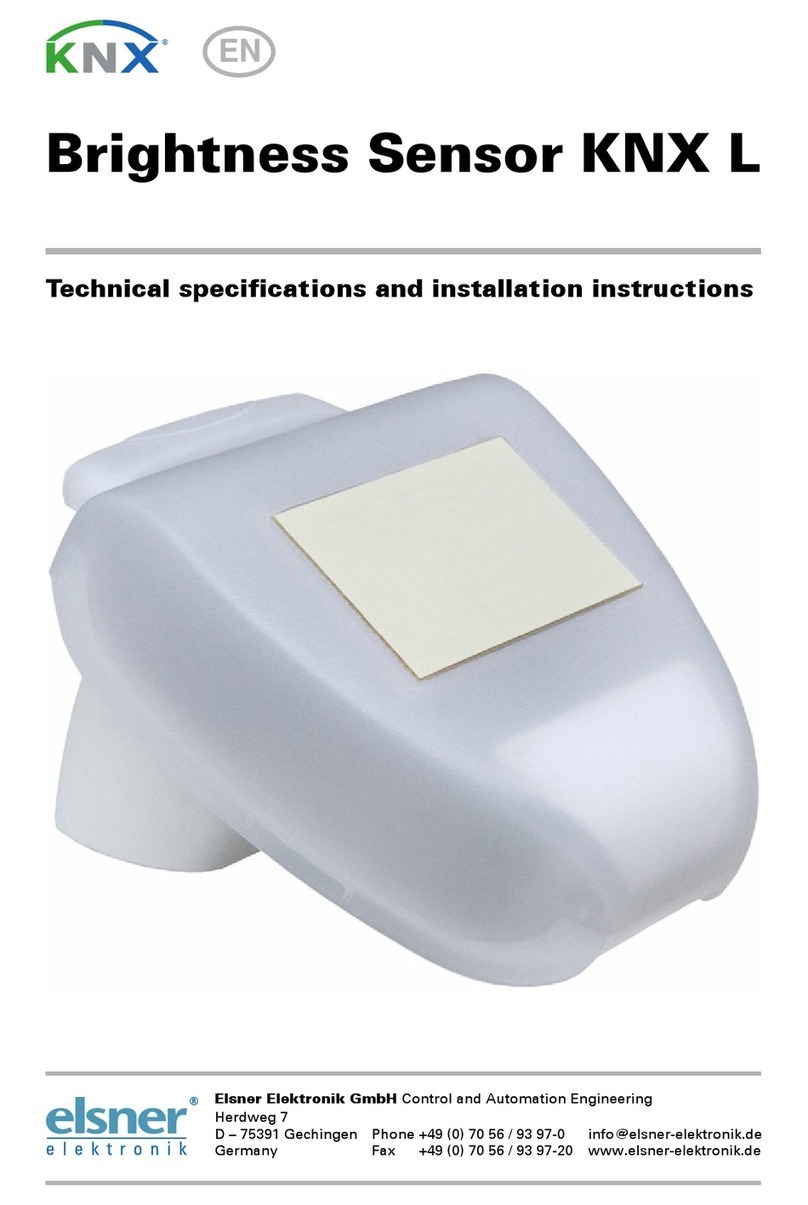
Elsner
Elsner KNX L User manual
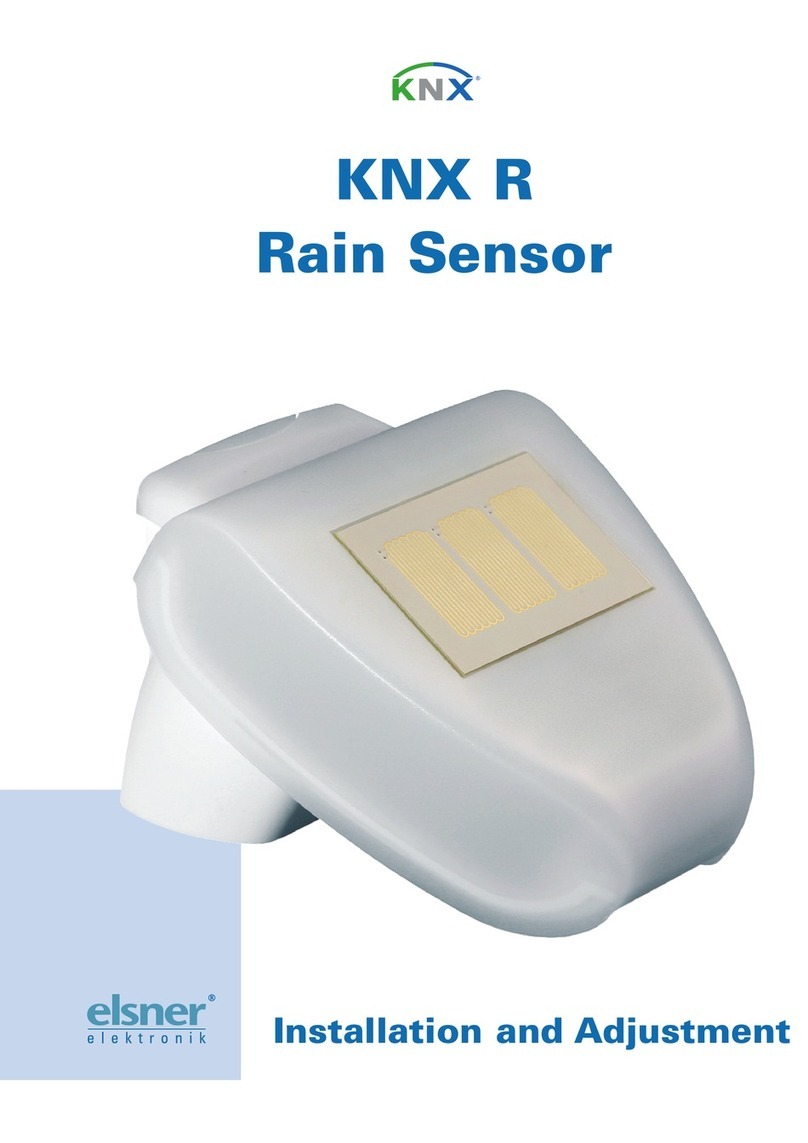
Elsner
Elsner KNX R Guide
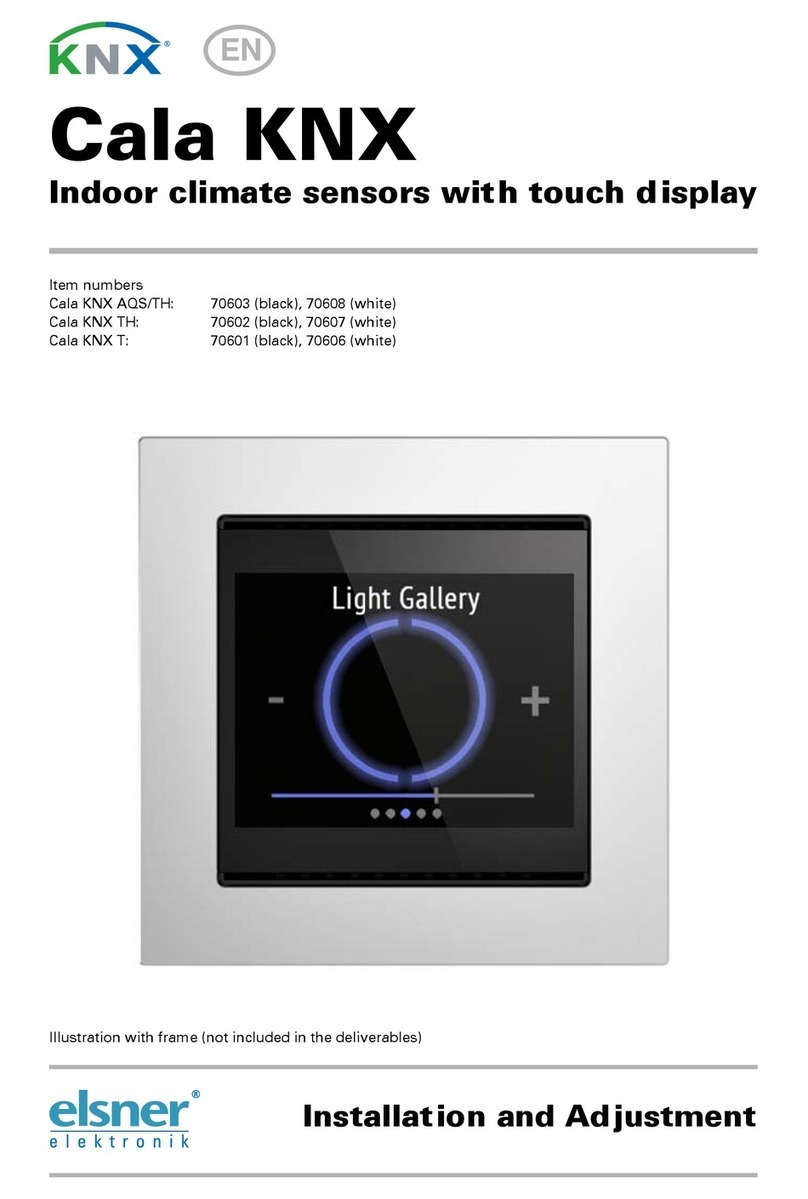
Elsner
Elsner Cala KNX AQS/TH Guide

Elsner
Elsner KNX VOC-UP basic Guide
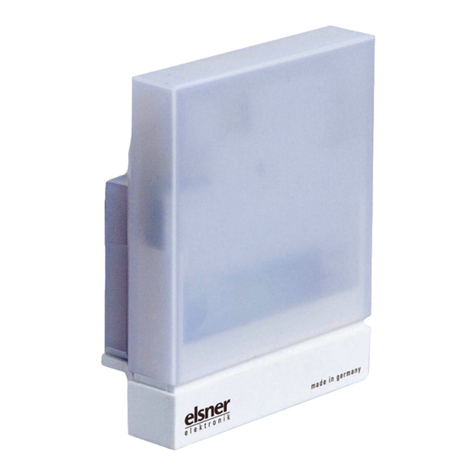
Elsner
Elsner Vari KNX 3L Guide
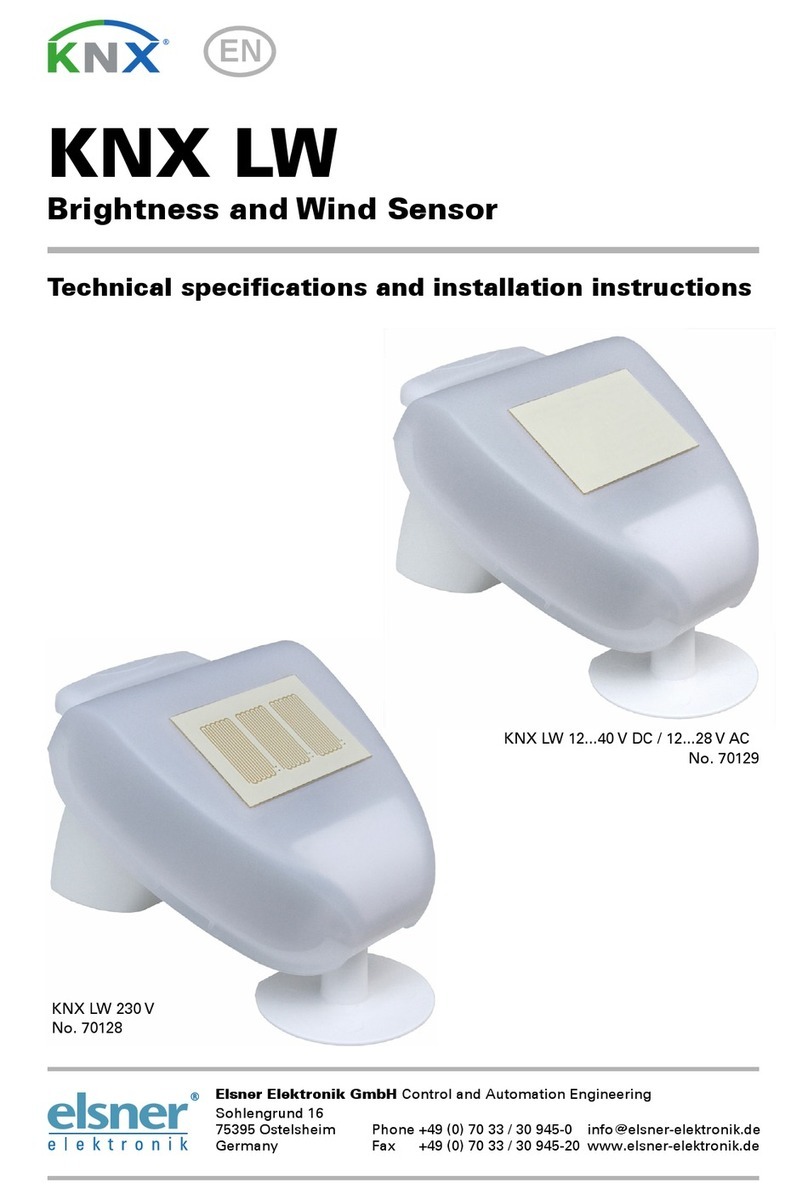
Elsner
Elsner KNX LW Series User manual
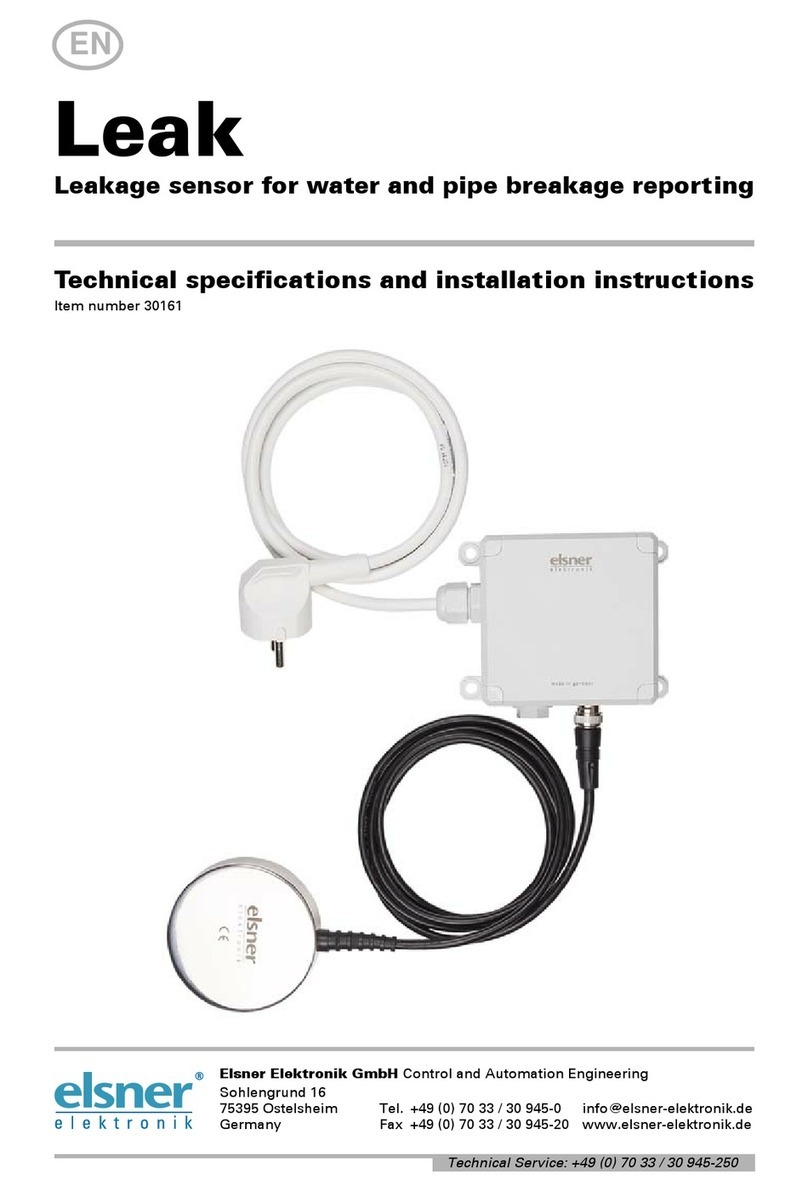
Elsner
Elsner Leak User manual

Elsner
Elsner KNX AQS/TH Guide
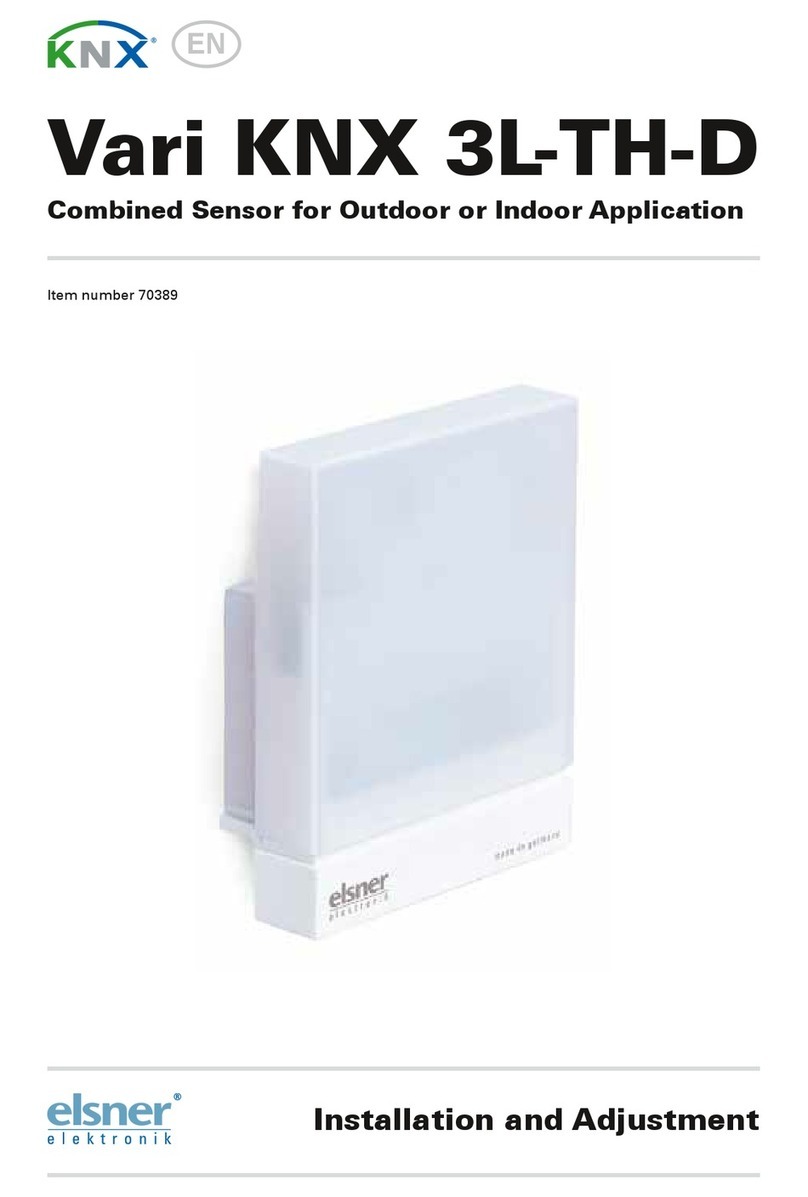
Elsner
Elsner Vari KNX 3L-TH-D Guide
Popular Accessories manuals by other brands
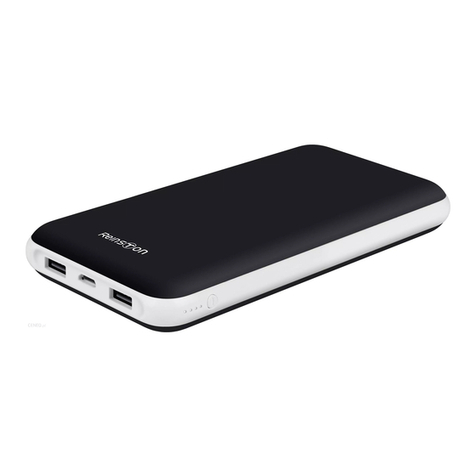
Reinston
Reinston EPB011 user manual

Safety Technology International
Safety Technology International STI-3610 quick start guide
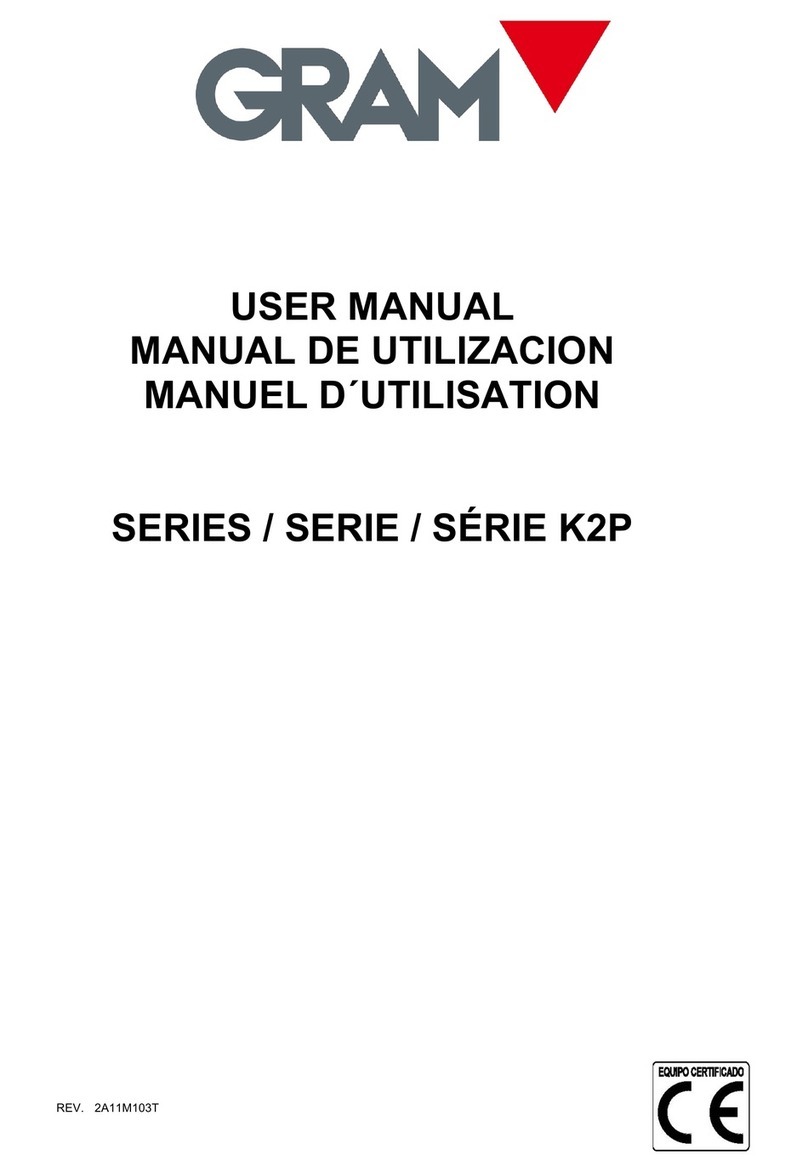
Gram Precision
Gram Precision K2P Series user manual
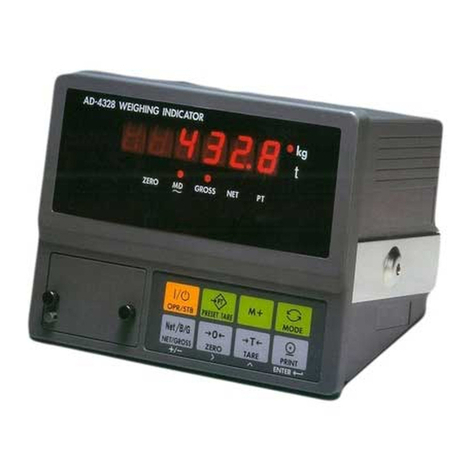
A&D
A&D AD-4328 specification

Aeotec
Aeotec DSB05106-ZWUS user manual

Diffraction
Diffraction Boltwood Cloud Sensor III user manual
